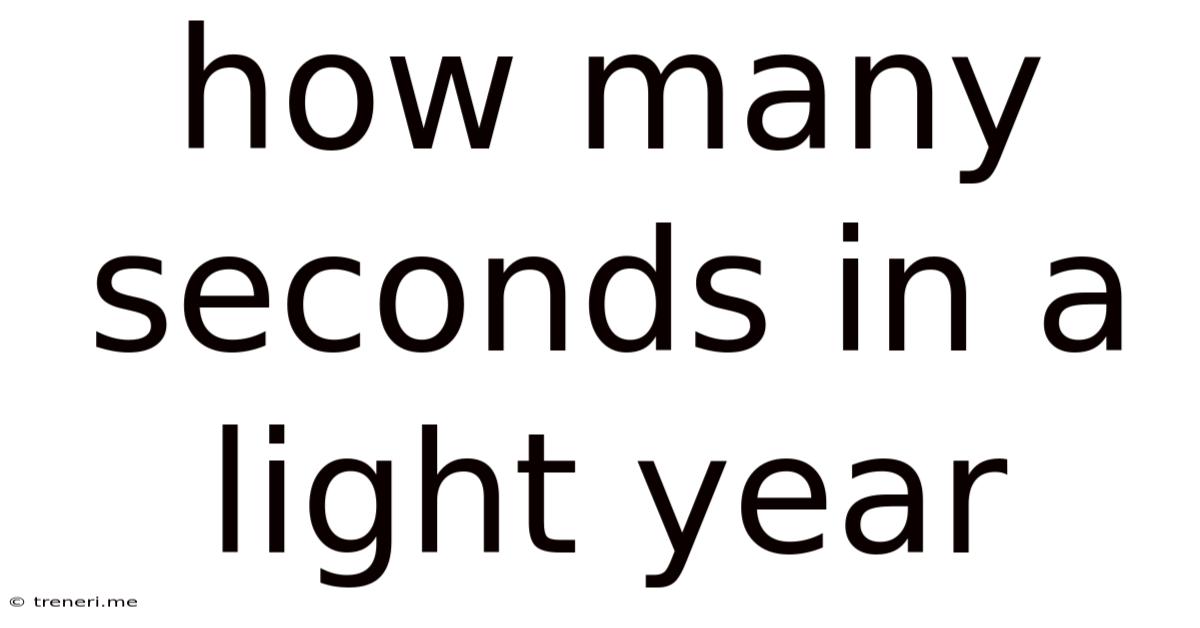How Many Seconds In A Light Year
Treneri
May 15, 2025 · 4 min read

Table of Contents
How Many Seconds Are There in a Light-Year? Unraveling the Cosmos
The concept of a light-year often sparks curiosity. It sounds like a unit of time, but it's actually a measure of astronomical distance. Understanding how many seconds are in a light-year requires a journey through the fundamentals of time, distance, and the speed of light. This article will delve into the calculations, explain the significance of this seemingly abstract number, and explore the vastness of space it represents.
Understanding the Fundamentals
Before we dive into the calculations, let's establish a clear understanding of the key components:
1. The Speed of Light
Light travels incredibly fast, approximately 299,792,458 meters per second (or roughly 186,282 miles per second) in a vacuum. This constant speed, denoted by 'c', is a cornerstone of physics and crucial for our calculations. It's important to remember that this is the speed of light in a vacuum. Light travels slightly slower through other mediums like air or water.
2. A Year: Defining the Timeframe
A year, for our purposes, will be considered a Julian year, which is precisely 31,557,600 seconds. This is a standard astronomical year that simplifies calculations. A Julian year is slightly longer than a typical calendar year, accounting for leap years.
3. Light-Year: A Measure of Distance
A light-year isn't a unit of time; it's the distance light travels in one Julian year. This means it's the speed of light multiplied by the duration of a Julian year.
The Calculation: Seconds in a Light-Year
Now, let's perform the calculation to determine the number of seconds in the distance covered by light in a year:
Step 1: Speed of Light in meters/second: 299,792,458 m/s
Step 2: Seconds in a Julian Year: 31,557,600 s
Step 3: Calculation: To find the distance of a light-year in meters, we multiply the speed of light by the number of seconds in a year:
299,792,458 m/s * 31,557,600 s = 9,460,730,472,580,800 meters
This is the distance light travels in one year. However, the question asks about seconds within that distance. The number of seconds itself doesn't change; it's still 31,557,600 seconds in a year. The light-year represents the distance covered during those 31,557,600 seconds.
Therefore, there aren't "seconds in a light-year" in the sense of a contained quantity of seconds. Instead, a light-year represents the distance light travels in 31,557,600 seconds.
The Immensity of a Light-Year
The sheer magnitude of a light-year is almost incomprehensible. To illustrate:
-
The closest star to our sun (Proxima Centauri) is approximately 4.24 light-years away. This means it takes light 4.24 years to travel from Proxima Centauri to Earth. That's equivalent to over 133 million seconds!
-
Our galaxy, the Milky Way, is estimated to be 100,000 to 200,000 light-years across. Imagine the immense timescale involved in traversing such a vast distance.
-
The observable universe is estimated to be 93 billion light-years in diameter. This number is so staggering that it defies easy comprehension.
Why This Calculation Matters
Understanding the relationship between light-years, the speed of light, and the number of seconds in a year is crucial for several reasons:
-
Astronomical Calculations: This forms the foundation for calculating distances to stars and galaxies. Astronomers rely on these calculations to map the universe and understand its structure.
-
Cosmology and Astrophysics: The concept of a light-year helps us grasp the vastness of the cosmos and the timescales involved in cosmic events.
-
Space Exploration: Understanding these distances is vital for planning and interpreting data from space missions, allowing for realistic estimations of travel times to other celestial bodies.
Beyond the Numbers: Conceptual Understanding
While the precise numerical calculation is important, it's equally important to understand the conceptual significance of a light-year. It's a way to represent unimaginable distances in a relatable context. It's a testament to the vastness of space and the limitations of our terrestrial perception of scale.
Thinking about the seconds within a light-year helps us appreciate the time it takes for light to travel these enormous distances. It underscores the sheer scale of the universe and the continuous expansion of our understanding of it.
Conclusion: Embracing the Vastness
The question of "how many seconds are in a light-year" leads us down a path of exploring fundamental concepts in physics and astronomy. While there aren't seconds within a light-year in a literal sense, the calculation reveals the immense distance light travels in one Julian year. This understanding is crucial for comprehending the vastness of the universe and the timescales involved in cosmic phenomena. The number itself, while impressive, is secondary to grasping the conceptual understanding of the immense distances that light-years represent. It's a reminder of our place in a universe far grander than we can easily fathom.
Latest Posts
Latest Posts
-
How To Find The Height Of A Uniform Distribution
May 15, 2025
-
Cuantos Centimetros Cubicos Hay En Un Metro Cubico
May 15, 2025
-
1 3 To The 4th Power
May 15, 2025
-
How Many Tablespoons Is 40 Grams Of Butter
May 15, 2025
-
How Many Square Feet In One Bundle Of Shingles
May 15, 2025
Related Post
Thank you for visiting our website which covers about How Many Seconds In A Light Year . We hope the information provided has been useful to you. Feel free to contact us if you have any questions or need further assistance. See you next time and don't miss to bookmark.